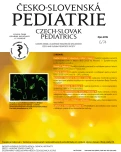Functional results of patients with cleft palate between 1993 and 2006 in Moravia II – Speech development
Authors:
Z. Dvořák 1,2; M. Pešlová 3
Authors‘ workplace:
Lékařská fakulta Masarykovy Univerzity, Brno
1; Klinika plastické a estetické chirurgie FN U sv. Anny, Brno
2; Foniatrická a ORL ambulance, Brno-Černá Pole
3
Published in:
Čes-slov Pediat 2019; 74 (6): 328-337.
Category:
Original Papers
Overview
Objective: To evaluate the results of palatal reconstruction in children with cleft palate based on the therapeutic results of the multidisciplinary team of the Cleft center at the Department of Plastic and Aesthetic Surgery of St. Anna’s Faculty Hospital in Brno (KPECH) focusing on the results of phoniatric controls.
Method: The basic set consisted of 919 patients operated from January 1, 1993 to December 31, 2006 at KPECH. Results of phoniatric controls were detected in 628 patients, 82 children were excluded from the study for an associated syndrome or a psychomotoric retardation. The resulting group consisted of 546 children. The results of speech development according to Brohm and the presence of hypernasality in 3rd, 4th, 5th and 6th years of life of the child were compared, based on the type of defect, gender and type of the surgical cleft palate reconstruction techniques used.
Results: The speech development is least altered in cleft lip, then cleft palate, and most altered in cleft lip and palate without a great difference between the unilateral and bilateral form. There is no more significant variation in the speach development and presence of hypernasality related to gender. When comparing surgical methods, children with cleft of soft palate operated by Furlow technique showed statistically significantly better speech development at 3 and 5 years of age than the children operated by two-flap palatoplasty with intravelar veloplasty (IVV). When comparing the two-flap palatoplasty with IVV or without IVV, there was a significant difference in 6-year-old patient with cleft palate and 4-year-old children with cleft lip and palate in favor of the intravelar veloplasty.
Conclusion: The best therapeutic results achieve the Furlow's palatoplasty, both in terms of speech development and hypernasality outcomes in patients with the isolated cleft palate. The two-flap palatal reconstruction with the intravelular veloplasty is indicated for the cleft lip and palate, at the price of a higher percentage of perforations and palatal scaring because it has better speech results and a lower presence of hypernasality than the two-flap palatoplasty without IVV.
Keywords:
cleft lip – cleft palate – orofacial cleft – velofaryngeal insufficiency – speech disorders
Sources
1. Novák A. Foniatrie a pedaudiologie. 1. Poruchy komunikačního procesu zpŭsobené sluchovỳmi vadami [Internet]. Praha: Alexej Novák, 1994 : 1–131. Dostupné z: https://books.google.cz/books?id=RAiCNAAACAAJ.
2. Dvořák Z, Veselý J, Konvičková E, et al. Standardy multidisciplinární péče o dítě s rozštěpem obličeje. Čes-slov Pediat 2009; 64 (5): 236–241.
3. Novák A. Foniatrie a pedaudiologie. 3. Základy fyziologie a patofyziologie řeči, diagnostika a léčba poruch řeči. Praha: Unitisk s.r.o., 1997 : 1–111.
4. Sloan GM, Zajac DJ. Velofaryngeal dysfunction. In: Mathes SJ (ed). Pediatric Plastic Surgery. 2nd ed. Philadelphia, Pa: Saunders Elsevier, 2006 : 311–37.
5. Kerekrétiová A. Velofaryngální dysfunkce a palatolalie. Praha: Grada, 2008 : 1–203.
6. Kummer AW. Evaluation of speech and resonance for children with craniofacial anomalies. Facial Plast Surg Clin N Am 2016; 24 (4): 445–451.
7. Kuehn DP, Moller KT. The state of the art: Speech and language issues in the cleft palate population. Cleft Palate Craniofac J 2000; 37 (4): 348.
8. Dvořák Z. Rozštěpové vady obličeje u dětí. In: Smečková G (ed). Reflexe logopedie v současné teorii a praxi: sborník příspěvků. Katedra speciální pedagogiky. Olomouc: Univerzita Palackého, 2004.
9. Brohm F. O vývoji dětské řeči a jejích vadách. Praha: Orbis, 1956 : 1–152.
10. Sovák M. Logopedie předškolního věku. Praha: SPN, 1984 : 1–283.
11. Košková O, Vokurková J, Vokurka J, et al. Treatment outcome after neonatal cleft lip repair in 5-year-old children with unilateral cleft lip and palate. Int J Pediatr Otorhinolaryngol 2016; 87 : 71–77.
12. Černý L, Fišer J. Foniatrická péče. In: Dušková M (ed). Pokroky v sekundární léčbě nemocných s rozštěpem. Hradec Králové: Olga Čermáková, 2007 : 145–149.
13. Klenková J. Logopedie: narušení komunikační schopnosti, logopedická prevence, logopedická intervence v ČR, příklady z praxe. Praha: Grada, 2006 : 1–224.
14. Moller KT, Starr CD, Johnson SA. A parent’s guide to cleft lip and palate. Minneapolis: University of Minnesota Press, 1990 : 1–130.
15. Vokurková J. Rozštěpové vady obličeje. Disertační práce. Brno: LF Masarykovy univerzity, 2000 : 1–75.
16. Gunther E, Wisser JR, Cohen MA, Brown AS. Palatoplasty: Furlow’s double reversing Z-plasty versus intravelar veloplasty. Cleft Palate-Craniofacial J Off Publ Am Cleft Palate-Craniofacial Assoc 1998; 35 (6): 546–549.
17. Marsh JL, Grames LM, Holtman B. Intravelar veloplasty: A prospective study. Cleft Palate J 1989; 26 (1): 46–50.
18. Bardach J. Salyer & Bardach’s Atlas of Craniofacial & Cleft Surgery (Vol. 2). 1st ed. Philadelphia, New York: Lippincott Williams & Wilkins, 1999 : 1–854.
Labels
Neonatology Paediatrics General practitioner for children and adolescentsArticle was published in
Czech-Slovak Pediatrics

2019 Issue 6
Most read in this issue
- The problem of an early diagnostic procedure in neuroinfection – case report
- Functional results of patients with cleft palate between 1993 and 2006 in Moravia I – Epidemiology and surgical results
- False positivity in newborn screening of 21-hydroxylase deficiency
- Antibody-mediated rejection in children after kidney transplantation
